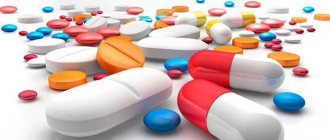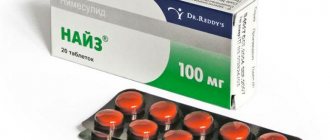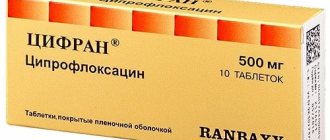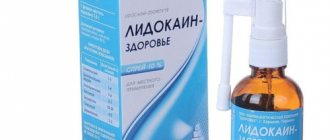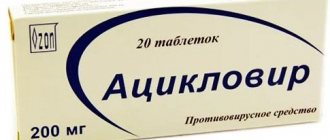Ibuprofen is rightfully considered the most effective and common remedy for treating the symptoms of colds and acute respiratory viral infections. Some patients successfully relieve fever with its help and consider it an antipyretic, while others relieve serious pain of a chronic nature, for example, in the spine. The fact is that Ibuprofen has three properties at the same time: anti-inflammatory, analgesic and antipyretic.
Ibuprofen
Indications for use
Ibuprofen belongs to the group of non-steroidal anti-inflammatory drugs (NSAIDs) - derivatives of phenylpropionic acid. In the instructions for tablets and capsules for adults, we see primarily prescriptions related to the symptomatic treatment of diseases of the joints or spine (rheumatoid arthritis, osteoarthritis, bursitis, sciatica), the fight against pain from injuries, myalgia and neuritis. In children's forms, we find the following indications: sore throat, pain with otitis media, teething, reduction of fever during ARVI or influenza, relief of symptoms of fever during childhood infections and post-vaccination reactions.
Of course, the indications are not limited to those mentioned above. We list here the most common types of pathologies where Ibuprofen does an excellent job eliminating inflammation and pain:
- Pathologies of the musculoskeletal system, pain relief: ankylosing spondylitis, radiculitis, spinal osteochondrosis, exacerbation of gout, polyarthrosis, psoriatic arthritis, tendinitis, inflammation of soft tissues in injuries, back pain, joint pain, trauma, sprains, dislocations, myalgia of various types .
- Diseases of the peripheral nervous system: neuralgia and neuritis.
- Gynecology: primary dysmenorrhea, secondary dysmenorrhea, pain during painful menstruation, with adnexitis.
- Relief of various types of pain: toothache, headache, migraine, sore throat, ear pain with otitis media, muscle pain.
- Use as an antipyretic for fever, flu, ARVI and colds. Increased temperature in infectious and inflammatory diseases.
- Relief after vaccination, including against coronavirus.
Ibuprofen Belmed Tablets, box, 50 pcs, 200 mg, for oral administration, film-coated, blister
Side effect
Gastrointestinal tract (GIT): NSAID gastropathy (abdominal pain, nausea, vomiting, heartburn, loss of appetite, diarrhea, flatulence, constipation; rarely - ulceration of the gastrointestinal mucosa, which in some cases is complicated by perforation and bleeding); irritation or dryness of the oral mucosa, pain in the mouth, ulceration of the gum mucosa, aphthous stomatitis, pancreatitis.; Hepato-biliary system: hepatitis; Respiratory system: shortness of breath, bronchospasm; Sense organs: hearing impairment: hearing loss, ringing or tinnitus; visual impairment: toxic damage to the optic nerve, blurred vision or double vision, scotoma, dryness and irritation of the eyes, swelling of the conjunctiva and eyelids (allergic origin); Central and peripheral nervous system: headache, dizziness, insomnia, anxiety, nervousness and irritability, psychomotor agitation, drowsiness, depression, confusion, hallucinations, rarely - aseptic meningitis (more often in patients with autoimmune diseases); Cardiovascular system: heart failure, tachycardia, increased blood pressure.; Urinary system: acute renal failure, allergic nephritis, nephrotic syndrome (edema), polyuria, cystitis.; Allergic reactions: skin rash (usually erythematous or urticaria), pruritus, angioedema, anaphylactoid reactions, anaphylactic shock, bronchospasm or dyspnea, fever, erythema multiforme exudative (including Stevens-Johnson syndrome), toxic epidermal necrolysis (Lyell's syndrome) , eosinophilia, allergic rhinitis.; Hematopoietic organs: anemia (including hemolytic, aplastic), thrombocytopenia and thrombocytopenic purpura, agranulocytosis, leukopenia.; Other: increased sweating; The risk of developing ulcerations of the mucous membrane of the gastrointestinal tract, bleeding (gastrointestinal, gingival, uterine, hemorrhoidal), visual impairment (impaired color vision, scotoma, amblyopia) increases with long-term use in large doses.; Laboratory parameters:; - bleeding time (may increase); - serum glucose concentration (may decrease); - creatinine clearance (may decrease); - hematocrit or hemoglobin (may decrease); - serum creatinine concentration (may increase); - activity of “liver” transaminases (may increase); If side effects occur, you should stop taking the drug and consult a doctor.
What forms does Ibuprofen come in?
In pharmacies you can find four dosage forms of the drug:
- If there are no contraindications related to the gastrointestinal tract, then people usually choose tablets or capsules.
- In cases where there is a stomach disease in the acute stage or the patient for some reason cannot swallow a tablet, suppositories are prescribed.
- Syrups are prescribed to infants. Most pediatricians prefer to reduce fever using Ibuprofen rather than Paracetamol, since the former acts faster and longer, and also has a lower safety profile due to the absence of toxic metabolites.
- For pain in the joints, muscles, back, and injuries, the ointment is ideal.
Instructions for taking Ibuprofen for adults and children.
- A single dosage for an adult is 200 mg; in case of severe pain, you can take 400 mg, the dosage frequency is 3-4 times a day, but not more than 1200 mg per day.
- A single dose for a child over 6 years old is 200 mg, can be taken 3-4 times a day. The maximum dosage for children per day differs by age as follows: for children 12-17 years old - 1000 mg; for children aged 6 to 12 years - 800 mg.
Ibuprofen Welfarm for adults
How many days can you take Ibuprofen?
The drug is taken for 2-3 days; if the patient’s condition does not improve or becomes worse, it is necessary to stop taking it and consult a doctor.
Ibuprofen MAX, tablets
Use internally, preferably between meals. In order to minimize the risk of adverse reactions, ibuprofen should be taken in the minimum effective dose and for the shortest period necessary to achieve a clinical effect.
Ibuprofen MAX is prescribed to adults, as well as to children over 12 years of age and weighing 40 kg or more.
The dosage regimen is set individually and depends on the indications. Typically, adults and children over 12 years of age (whose body weight is 40 kg or more) ibuprofen are prescribed at an initial dose of 400 mg 1-2 times a day; if necessary, the dose can be increased to 400 mg 3 times a day to achieve a therapeutic effect. It is not recommended to take more than 3 tablets in 24 hours (1200 mg).
If you miss the next dose of the drug, it is recommended to take the dose in accordance with the prescribed dosage regimen, without doubling the amount of the drug.
Patients with kidney failure
Based on pharmacokinetic data, no dose reduction is required in patients with mild to moderate renal impairment (creatinine clearance 30–80 ml/min). In severe renal failure (creatinine clearance <30 ml/min), ibuprofen is contraindicated.
Patients with liver failure
In patients with mild to moderate liver dysfunction, no dose reduction is required (use in severe liver failure is contraindicated).
Elderly patients
No special dose adjustment is required if renal function is preserved. However, given that older adults are at increased risk of serious adverse reactions, it is recommended that the lowest effective therapeutic dose be administered for the shortest possible duration. During treatment, regular monitoring is necessary to avoid gastrointestinal bleeding. If renal function is impaired, the dosage should be adjusted individually. If treatment is required for more than 7 days, regular monitoring of renal function is required.
Children
Given that the maximum daily dose of ibuprofen in children is 20 mg/kg, it is not advisable to prescribe ibuprofen 400 mg tablets to children and adolescents weighing less than 40 kg and under 12 years of age.
If ibuprofen is required for more than 3 days or symptoms worsen in adults, children and adolescents 12 to 18 years of age, you should consult your doctor.
Ibuprofen for children
Ibuprofen in the form of syrup for children is used from the age of 3 months and can begin to act within 15 minutes. The tablets take effect within 30 minutes.
How to use baby syrups?
Children's syrups are usually made using fruit fillings and therefore children take them with pleasure. For the little ones there is a measuring syringe complete with syrup, where 1 ml contains a certain dose of Ibuprofen.
It is necessary to follow the manufacturer's instructions, the maximum daily dosage for a child is 30 mg per 1 kg of body weight, the interval between doses is from 6 to 8 hours. As we noted earlier, the duration of treatment should not exceed 3 days. Syrups are popular and therefore they are often designed for use up to 12 years, although tablets can also be used from 6 years.
The dose of syrup for a child can be determined from the table.
| Child's age | Body weight in kg | Dosage | Maximum dose per day |
| 3-6 months | 5kg-7.6kg | 50 mg up to 3 times a day | 150 mg |
| 6-12 months | 7.7-9 kg | 50 mg up to 3-4 times a day | 200 mg |
| 1-3 years | 10-16 kg | 100 mg up to 3 times a day | 300 mg |
| 4-6 years | 17-20 kg | 150 mg up to 3 times a day | 450 mg |
Instructions for use of Ibuprofen (Method and dosage)
Ibuprofen tablets, instructions for use
The optimal dosage for children over 12 years of age and adults is 3-4 tablets of 200 mg. To achieve the desired effect, the dose can be increased to 1.2 g/day. (it should be divided into 3 doses).
When the required therapeutic effect is achieved, the daily dose should be reduced to 3-4 tablets of 200 mg per day.
The first dose is taken in the morning before meals, with a sufficient amount of liquid (this will allow the drug to be absorbed more quickly into the gastrointestinal tract). Later throughout the day, tablets are taken after meals.
The highest single dose is 400 mg (2 tablets of 200 mg), daily dose is 1.2 g (no more than 6 tablets of 200 mg within 24 hours). It is not recommended to take a repeat dose earlier than after 4 hours. Without medical advice, the drug should be taken for no more than 5 days in a row. Also, consultation with a specialist is necessary in cases where the tablets are used to treat a child under 12 years of age.
A child 6-12 years old can be given 1 tablet up to 4 times a day. A prerequisite is a weight of more than 20 kg. An interval of at least 6 hours should be maintained between tablet doses. The highest dose for this group of patients is 30 mg/kg/day.
There is no difference in how to take drugs from different manufacturers (for example, Ibuprofen-Belmed, Ibuprofen-Hemofarm or Ibuprofen-Darnitsa).
Instructions for candles
Suppositories are used rectally.
For pain and fever, the drug should be dosed based on the age and weight of the child. A single dose varies from 5 to 10 mg/kg. Frequency of applications - 3-4 rubles/day. The highest dose is 30 mg/kg/day.
The instructions for use for children indicate that patients weighing from 5.5 to 8 kg (3-9 months) should be administered 60 mg (1 suppository) every 6-8 hours, but no more than 3 suppositories per day. day. The highest dose for patients weighing from 8 to 12.5 kg (9-24 months) is 240 mg/day. (4 suppositories of 60 mg each).
To relieve fever, which is a consequence of immunization, in children under 12 months. 1 suppository of 60 mg should be administered and, if necessary, another 1 after 6 hours.
Ibuprofen suppositories can be used as an antipyretic for children for no more than 3 days. in a row, and as an analgesic - no more than 5 days. contract.
If fever persists after this time, consult a doctor.
Ibuprofen gel, instructions for use
Adults and children over 12 years of age should squeeze out a strip of gel 4-10 cm long and rub the drug with light movements until completely absorbed into the area of pain projection.
The procedure can be repeated no earlier than 4 hours later. Ibuprofen is used no more than 4 times during the day. The dose depends on the extent of the painful area and varies from 50 to 125 mg.
For children 6-12 years old, a single dose is equal to the volume of a gel strip 2 to 4 cm long. The drug can be used no more than 3 times a day.
Treatment is continued for 2 to 3 weeks.
Ibuprofen ointment, instructions for use
The ointment is applied externally in the same way as the gel. The medicine is applied to the painful area 3 or 4 times a day. within 2-3 weeks. A single dose is equal to the volume of a gel strip 5 to 10 cm long.
How to take children's Ibuprofen (suspension)?
The suspension is given to children 3 times a day. at a dose of 5-10 mg/kg.
Children under one year of age can be given the drug only as prescribed by a pediatrician. The highest dose for infants is 10 ml/day. (2.5 ml 4 times/day).
Syrup for children from one to 12 years old is given 3 rubles per day. in a dose of 5 to 15 ml.
If pain and fever in a 3-6 month old child are a consequence of vaccination, 2 times a day should be given per 5-7.6 kg of body weight. 2.5 ml of suspension. After the first dose, the drug is repeated no earlier than 6 hours later.
Instructions for Ibuprofen solution for children
Ibuprofen injections are prescribed exclusively to premature infants with heart pathologies (in particular, with an unclosed ductus arteriosus).
Treatment is carried out in the intensive care unit and under the supervision of a neonatologist. Ibuprofen is administered intravenously 3 times at intervals of 24 hours. The dosage is selected depending on the child’s weight.
The first dose is 10, the second and third are 5 mg/kg.
The drug is infused slowly (over 15 minutes), preferably undiluted. If necessary, the injected volume is adjusted with 0.9% NaCl solution (or 5% glucose). The remaining unused solution is disposed of.
When determining the volume of injected solution, the total daily volume of prescribed fluid is taken into account.
If, after the child receives 1 or 2 doses, he develops overt oliguria or anuria , the next dose is administered only after restoration of normal diuresis .
If the botal duct is open 24 hours after the last dose or opens again, a repeat course is allowed, which also consists of 3 doses of the drug. If in this case it is not possible to achieve closure of the duct, the child may require surgical treatment.
Ibuprofen ointment 5%
The drug is widely used as an external agent. Ointments and gels are produced in pure form or with the addition of cooling agents.
The ointment helps with arthritis, sprains, pain from damaged ligaments, back pain, sports injuries, and neuralgia.
How to use Ibuprofen ointment?
Usually the ointment is prescribed to adults and children over 14 years of age.
The dosage depends on the manufacturing company. A gel from 4 to 10 cm approximately contains 50 – 125 mg of the drug and this is a single dose. The product should be gently rubbed into the skin. Reapply no earlier than after 4 hours. The maximum daily dose is 500 mg.
Ibuprofen ointment
Side effect
- Like all medications, Ibuprofen can cause allergic reactions: skin itching, urticaria, Quincke's edema, anaphylactic reactions, incl. anaphylactic shock. In this case, you should stop taking the drug and consult a doctor.
- The following side effects may be observed on the part of the digestive system: pancreatitis, nausea, vomiting, erosive and ulcerative lesions of the gastrointestinal tract, stomach and abdominal pain, stomatitis, liver dysfunction, hepatitis.
- Genitourinary system: polyuria, renal dysfunction, renal failure, edema, cystitis, nephrotic syndrome, interstitial nephritis.
- Nervous system and sensory organs: irritation and dry eyes, ringing in the ears, hallucinations, psychomotor agitation, confusion, headaches, anxiety, irritability.
- Respiratory system: allergic rhinitis, bronchospasm, shortness of breath.
- Cardiovascular system: agranulocytosis, leukopenia, increased pulse, hypertension, heart failure.
IBUPROFEN-CHEMOPHARM
Interaction
Concomitant use of ibuprofen with acetylsalicylic acid and other NSAIDs is not recommended.
When administered simultaneously, ibuprofen reduces the anti-inflammatory and antiplatelet effects of ASA (an increase in the incidence of acute coronary insufficiency in patients receiving small doses of ASA as an antiplatelet agent is possible after starting ibuprofen).
When prescribed with anticoagulant and thrombolytic drugs (alteplase, streptokinase, urokinase), the risk of bleeding simultaneously increases.
Concomitant use with serotonin reuptake inhibitors (citalopram, fluoxetine, paroxetine, sertraline) increases the risk of developing serious gastrointestinal bleeding. Cefamandole, cefaperazone, cefotetan, valproic acid, plicachycin increase the incidence of hypoprothrombinemia.
Cyclosporine and gold preparations enhance the effect of ibuprofen on the synthesis of prostaglandins in the kidneys, which is manifested by increased nephrotoxicity. Ibuprofen increases the plasma concentration of cyclosporine and the likelihood of developing its hepatotoxic effects.
Drugs that block tubular secretion reduce excretion and increase plasma concentrations of ibuprofen.
Inducers of microsomal oxidation (phenytoin, ethanol, barbiturates, rifampicin, phenylbutazone, tricyclic antidepressants) increase the production of hydroxylated active metabolites, increasing the risk of developing severe hepatotoxic intoxications.
Microsomal oxidation inhibitors reduce the risk of hepatotoxicity.
Reduces the hypotensive activity of vasodilators (including slow calcium channel blockers (SCBC), angiotensin-converting enzyme (ACE) inhibitors), natriuretic and diuretic activity - furosemide and hydrochlorothiazide.
Reduces the effectiveness of uricosuric drugs, enhances the effect of indirect anticoagulants, antiplatelet agents, fibrinolytics (increasing the risk of hemorrhagic complications), enhances the ulcerogenic effect with bleeding of mineralocorticosteroids (MCS) and glucocorticosteroids (GCS), colchicine, estrogens, ethanol.
Enhances the effect of oral hypoglycemic drugs (including sulfonylurea derivatives) and insulin.
Antacids and cholestyramine reduce the absorption of ibuprofen.
Increases the blood concentration of digoxin, lithium and methotrexate.
Caffeine enhances the analgesic effect.
Myelotoxic drugs increase the manifestations of hematotoxicity of the drug.
Contraindications:
- Hypersensitivity to the components of the drug.
- Bleeding disorders, hemophilia.
- Hematopoietic disorders.
- Erosive and ulcerative lesions of the gastrointestinal tract in the acute stage, bleeding in the gastrointestinal tract.
- Kidney or liver failure.
- Severe heart failure.
- The period after coronary artery bypass surgery.
- “Aspirin triad” (aspirin intolerance, nasal polyps and bronchial asthma).
- Diseases of the optic nerve.
- Caution should be exercised when taking other NSAIDs.
- Simultaneous use of medication and alcoholic beverages is not recommended.
special instructions
- Ibuprofen is prescribed in a short course - three days. If therapy lasts 10 days or more, you should consult a doctor.
- Elderly patients need to carefully monitor the tolerability of the drug, as they are more likely to experience side effects.
- May temporarily reduce female reproductive function (the effect disappears after discontinuation).
- It may affect the ability to drive vehicles, so if the patient notices lethargy or drowsiness, he should refrain from driving vehicles and other activities where reaction speed is required.
Ibuprofen for children
Interaction with other drugs
Ibuprofen was created back in 1953 and is therefore well studied. Here we will briefly list its interactions with common drugs - this is mainly a group of cardiovascular drugs, some antibiotics. A complete list of drug interactions should be read in the instructions for the drug.
- Reduces the effect of ACE inhibitors, beta-blockers and some diuretics, such as furosemide.
- The effect may be enhanced when taken with anticoagulants.
- The activity of amlodipine decreases.
- Caution should be used when taking warfarin, methotrexate and lithium together.
- Interactions have been noted with cardiac glycosides, quinolone antibiotics, ethanol, barbiturates, rifampicin, phenylbutazone, cyclosporine, mifepristone, tacrolimus, zidovudine, cefoperazone, cefotetan, valproic acid.
Ibuprofen
The simultaneous use of ibuprofen with the following drugs should be avoided:
- acetylsalicylic acid: with the exception of low doses of acetylsalicylic acid (no more than 75 mg per day) prescribed by a doctor, since combined use may increase the risk of side effects. With simultaneous use, ibuprofen reduces the anti-inflammatory and antiplatelet effect of acetylsalicylic acid (an increase in the incidence of acute coronary insufficiency in patients receiving small doses of acetylsalicylic acid as an antiplatelet agent is possible after starting ibuprofen);
- other NSAIDs, in particular selective COX-2 inhibitors: simultaneous use of two or more drugs from the NSAID group should be avoided due to a possible increased risk of side effects;
Use with caution simultaneously with the following medications:
- anticoagulants and thrombolytic drugs: NSAIDs can enhance the effect of anticoagulants, in particular warfarin and thrombolytic drugs;
- antihypertensive drugs (ACE inhibitors and angiotensin II antagonists) and diuretics: NSAIDs may reduce the effectiveness of drugs in these groups. In some patients with impaired renal function (eg, dehydrated patients or elderly patients with impaired renal function), coadministration of ACE inhibitors or angiotensin II antagonists and cyclooxygenase inhibitors may lead to a deterioration of renal function, including the development of acute renal failure. (usually reversible). These interactions should be considered in patients taking coxibs concomitantly with ACE inhibitors or angiotensin II antagonists. In this regard, the combined use of the above drugs should be prescribed with caution, especially in the elderly. Patients should be prevented from dehydration and consideration should be given to monitoring renal function upon initiation of this combination treatment and periodically thereafter. Diuretics and ACE inhibitors may increase the nephrotoxicity of NSAIDs;
- glucocorticosteroids: increased risk of gastrointestinal ulcers and gastrointestinal bleeding;
- antiplatelet agents and selective serotonin reuptake inhibitors: increased risk of gastrointestinal bleeding.
- cardiac glycosides: simultaneous administration of NSAIDs and cardiac glycosides can lead to worsening heart failure, a decrease in glomerular filtration rate and an increase in the concentration of cardiac glycosides in the blood plasma;
- lithium preparations: there is evidence of the likelihood of an increase in the concentration of lithium in the blood plasma during the use of NSAIDs;
- methotrexate: there is evidence of the likelihood of an increase in the concentration of methotrexate in the blood plasma during the use of NSAIDs;
- cyclosporine: increased risk of nephrotoxicity with simultaneous administration of NSAIDs and cyclosporine;
- mifepristone: NSAIDs should be started no earlier than 8-12 days after taking mifepristone, since NSAIDs may reduce the effectiveness of mifepristone;
- tacrolimus: with simultaneous administration of NSAIDs and tacrolimus, the risk of nephrotoxicity may increase;
- zidovudine: simultaneous use of NSAIDs and zidovudine may lead to increased hematotoxicity. There is evidence of an increased risk of hemarthrosis and hematomas in HIV-positive patients with hemophilia who received concomitant treatment with zidovudine and ibuprofen;
- quinolone antibiotics: in patients receiving concomitant treatment with NSAIDs and quinolone antibiotics, the risk of seizures may increase;
— myelotoxic drugs: increased hematotoxicity;
- cefamandole, cefoperazone, cefotetan, valproic acid, plicamycin: increased incidence of hypoprothrombinemia;
- drugs that block tubular secretion: decreased excretion and increased plasma concentration of ibuprofen;
- inducers of microsomal oxidation (phenytoin, ethanol, barbiturates, rifampicin, phenylbutazone, tricyclic antidepressants): increased production of hydroxylated active metabolites, increased risk of developing severe intoxications;
— microsomal oxidation inhibitors: reducing the risk of hepatotoxicity;
- oral hypoglycemic drugs and insulin, sulfonylurea derivatives: enhanced effect of drugs;
- antacids and cholestyramine: decreased absorption;
- uricosuric drugs: decreased effectiveness of drugs;
- caffeine: increased analgesic effect.




